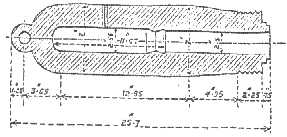The Gun - Rifled Ordnance: Mountain Artillery - The Screw GunIt seems the idea of a gun in two parts had its origin in Russia, having been proposed bin 1876 by Captain Kolokolzor, Director of a factory at Obuchow. In 1877 Colonel le Mesurier RA proposed an RML 7-pr (2.5-inch) steel gun made in two parts which screwed together, hence 'screw gun', the piece eulogised by Rudyard Kipling (1865-1936) in his poem on the subject. Twelve guns to le Mesurier's design made by the Elswick Ordnance Company (Armstrong's firm) were sent to Afganistan in 1879 and proved so satisfactory that a large number to a similar design were made at the Royal Gun Factory for the service. The RGF guns, designated Mark 2, differed from the EOC pattern mainly internally, eg in the shape of the sealing rings. Rifling consisted of eight PPS grooves, 0.05-in deep, with a twist increasing from one turn in 80 calibres to one in 30 at 3.53 inches from the muzzle, the remainder being uniform at that pitch. Gun and carriage dismantled were carried by five mules. The screw gun remained the armament of British moiuntain batteries until after the South African War (1899-1902). It was not popular among Gunners; although cordite had been introduced in 1892 'screw gun' cartridges were still filled with gunpowder, the smoke from which advertised a gun's position every time it fired. |
 Breech portion, 201 lbs. Breech portion, 201 lbs. Muzzle portion, 199 lbs. Muzzle portion, 199 lbs.
The Screw Gun, ie the RML 2.5-inch mountain gun Mark 1 |
|
Two mules each carried a third of the piece, a third the carriage, a fourth the wheels, and the fifth the rest, ie the axletree, elevating gear, rammer and other stores.
In its day the screw gun was considered the best mountain gun of its kind in the world.
WL Ruffell previous | index | next | History index | Home |